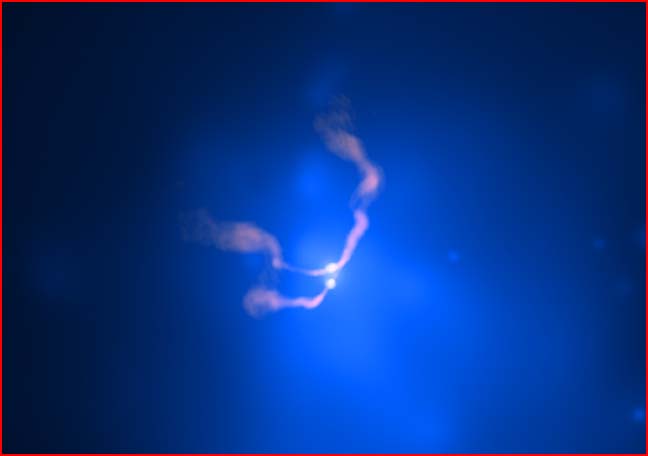
home •
about •
essential guide •
picture of the day •
thunderblogs •
news •
multimedia •
predictions •
products •
get involved •
contact
picture of the day archive subject index
Composite X-ray (blue) and radio (pink) image of the galaxy cluster Abell 400.
Credit: X-ray: NASA/CXC/AIfA/D.Hudson & T.Reiprich et al.; Radio: NRAO/VLA/NRL
Nov 14, 2006
Two "Black Holes?"
It seems that Abell 400, a galaxy cluster that has long enchanted astronomers, is provoking a new round of speculations, with little regard for the separation of fact and fiction.
The picture above combines X-ray and radio images of the galaxy cluster Abell 400. According to the press release from the Chandra X-Ray Observatory, the composite "shows radio jets immersed in a vast cloud of multimillion degree X-ray emitting gas that pervades the cluster."
"The jets emanate from the vicinity of two supermassive black holes (bright spots in the image)…. The peculiar dumbbell structure of this galaxy is thought to be due to two large galaxies that are in the process of merging."
Any substance with a temperature of "multimillion" degrees cannot possibly be a gas: It will be a completely ionized plasma. What the press release doesn’t say is that the X-rays in such cases are almost exclusively synchrotron radiation, not thermal radiation. That means the X-rays are emitted by very fast electrons spiraling in a strong magnetic field. The Abell 400 galaxies are under extreme electrical stress.
But electricity is not something astronomers are eager to hear about. They are not fond of electrical currents in space, because the possibility that electricity generates large scale structure is alien to their theoretical models. To generate the observed levels of energy seen in Abell 400—using nothing but the puny force of gravity—more matter would have to be squeezed into a galaxy than a galaxy could hold. But the theorists are mathematicians, and they work with equations, not with real objects. This permits them to ignore empirical limits on density and let the amount of matter per unit volume increase without limit: The "neutron stars" and "black holes" conjured through this mathematical license can be placed wherever needed to explain away the stunning and potentially embarrassing energy excesses.
The galaxies would still have to be large. But because of the two "close" bright spots, astronomers now speculate about "colliding black holes" that could form a "single super-supermassive black hole" in a few million years—a mathematicians delight whether or not anything of this sort actually occurs in the natural world.
But photographs of Abell clusters — there are over 4000 such clusters — point to a different conclusion. Halton Arp, the Galileo of the twentieth century, has shown that several are aligned along the spine of the Virgo Cluster. Their x-ray contours are elongated toward nearby active galaxies, and these galaxies often have jets directed toward the Abell clusters.
Some members of the Abell clusters are paired with a quasar or a BL Lac (a kind of fragmented quasar) across an active galaxy, presenting astronomers with a now-familiar paradox. Because quasars and their kin are small and faint and have rather larger redshifts than the active galaxies, convention assumes they are large and bright but far away. But as Arp points out, Hubble diagrams for Abell clusters have enormous dispersion, placing the astronomers' assumptions about redshift in doubt: "[T]here is no redshift-apparent magnitude relation for these clusters like that which is claimed to demonstrate a redshift-distance relation." [Seeing Red, p. 154] And their association with active galaxies suggests that they are "grown up" BL Lacs — that they are not far away, but actually small and faint and close to the nearby active galaxy. Arp discusses this issue at length in his book, Seeing Red.
Abell 400 is particularly interesting because it lies along the line of Local Group objects extending from the minor axis of M31 (the Andromeda galaxy), through M33, to 3C120 (the active galaxy with the "faster-than-light" jet). Along that line are also nebulous clouds "obviously interacting" with higher-redshift dwarf and low-luminosity spiral galaxies, strong radio and x-ray sources, and quasar groupings. Arp suggests that the objects in this line have been ejected from M31, as may have been our own galaxy.
The Abell 400 cluster would be a part of the "umbilicus'"that still connects us with our "mother", M31.
Submitted by Mel Acheson
___________________________________________________________________________Please visit our Forum
The Electric Sky and The Electric Universe available now!

|
|

|
EXECUTIVE EDITORS:
David Talbott, Wallace Thornhill
MANAGING EDITORS:
Steve Smith, Mel Acheson
CONTRIBUTING EDITORS: Dwardu Cardona, Ev Cochrane,
C.J. Ransom, Don Scott, Rens van der Sluijs, Ian Tresman
WEBMASTER: Brian Talbott
Copyright 2006: thunderbolts.info
![]()
home •
thunderblogs •
forum •
picture of the day •
resources •
team •
updates •
contact us

